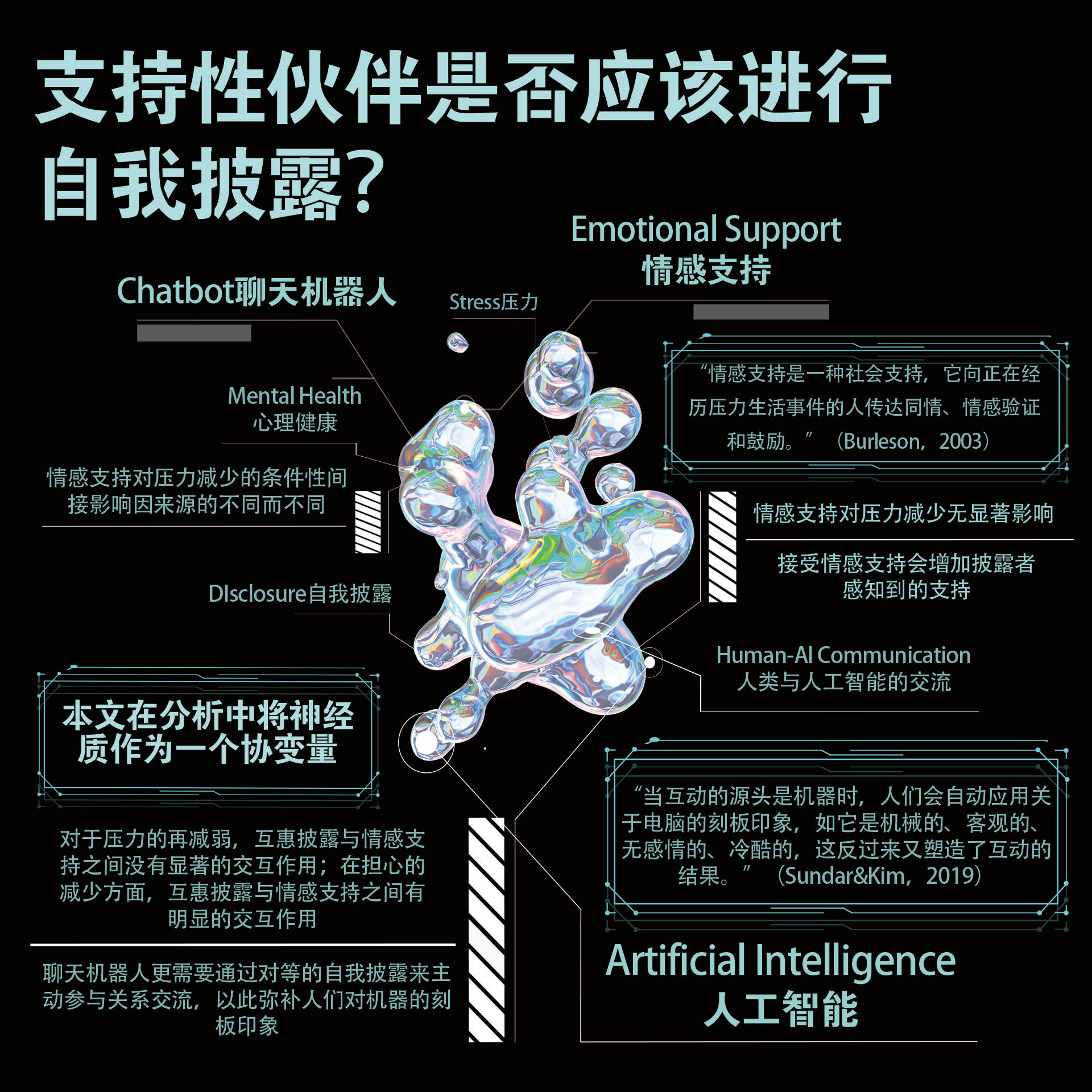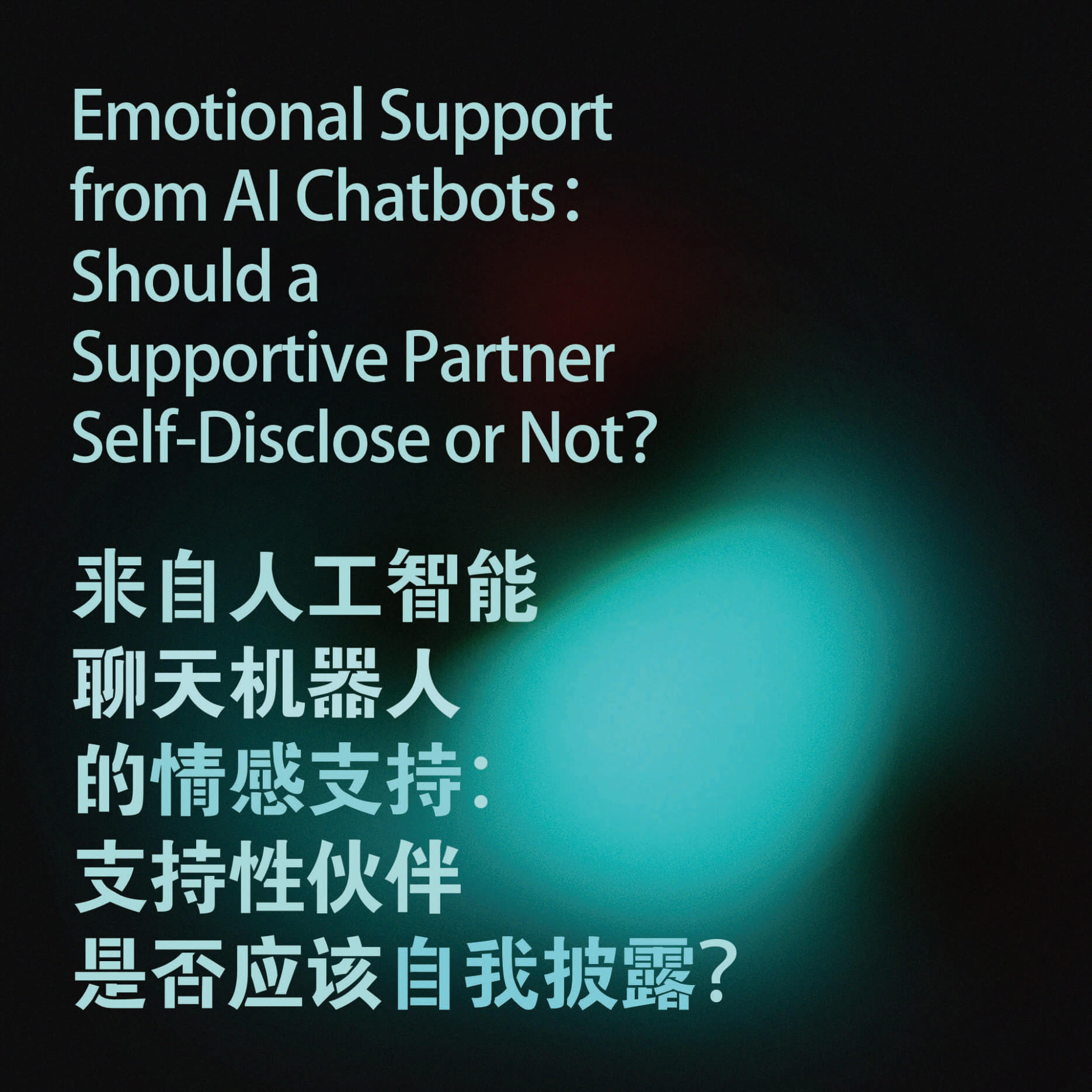来自人工智能聊天机器人的情感支持:支持性伙伴是否应该自我披露?
“I thougth what I ‘d do was, I’d pretend I was one of those deaf-mutes,or should I ?
我曾经想过变成一个堵上眼睛和耳朵,缄口不言的人,我应该这样做吗?”
————《攻壳机动队》
聊天机器人是一种沟通型人工智能,即能够以某种程度的人类智慧完成沟通任务的自动化系统。越来越多的聊天机器人被运用于心理健康服务之中。这种趋势促使我们需要加深对聊天机器人为人们所提供情感支持的理解:聊天机器人的情感支持对于减少人们的压力和担忧有效吗?他的有效性何时会被改变?本文主要研究了关系沟通如何与情感支持相互作用,影响人们的心理健康,以及情感支持来源如何影响其有效性,互惠的自我披露在减少压力和担忧中的调节作用,并推进了CASA框架在移情聊天机器人中的应用。
Chatbots are a type of communicative artificial intelligence, i.e. automated systems that can perform communication tasks with some degree of human intelligence. Increasingly, chatbots are being used in mental health services. This trend has led to a need for a deeper understanding of the emotional support chatbots provide to people: is the emotional support of chatbots effective in reducing people’s stress and worry? When will their effectiveness be altered? This paper focuses on how relational communication interacts with emotional support to influence people’s mental health and how sources of emotional support affect its effectiveness, the moderating role of reciprocal self-disclosure in reducing stress and worry, and advances the application of the CASA framework to empathic chatbots.
研究概述Research Overview:
关于压力:情感支持Talking about stress: Emotional support
情感支持的提供能帮助人类解决被他人关心和支持的基本需求,它向正处于压力或担忧之中的人们传递了同情与鼓励等种种情绪。当一个人正在表达自己的压力或担忧时,我们应该给予其支持而不是指责。获得有效的情感支持来源,能帮助披露者减少压力与担忧。这些观点已经在面对面以及以计算机为媒介的互动中被证实了。根据CASA框架,人们在面对计算机时的反应会与他们面对人类时的自然反应一样。基于以上观点,本文作出了以下假设:
The provision of emotional support helps humans address the basic need to be cared for and supported by others by conveying emotions such as empathy and encouragement to people who are undergoing stress or worry. When a person is expressing their stress or concern, we should be supportive rather than accusatory. Access to effective sources of emotional support can help the person disclosing to be less stressed and worried. These ideas have been proven in face-to-face as well as computer-mediated interactions. According to the CASA framework, people will react the same way when confronted with a computer as they would naturally react when confronted with a human. Based on these ideas, this paper makes the following assumptions:
H1:当对话伙伴提供情感支持的时候,披露者比不提供情感支持时减少更多的(a)压力和(b)担忧。
H2:情感支持(a)压力和(b)忧虑减少的积极影响是通过感知到的伴侣的支持性来中介的
H1:A discloser reduces more (a)stress and (b) worry when a conversational partner provides emotional support than when the partner does not.
H2:The positive effect of emotional support on (a)stress and (b)worry reduction is mediated through perceived supportiveness of the partner.
聊天机器人与人类作为对话伙伴的对比
Chatbot versus human as a conversational partner
尽管CASA框架认为人们面对计算机时会像面对他们面对人类时一般,现有的研究显示,在不同的背景下,人们对计算机和人类会表现出不同的反应。人类对于机器所固有的刻板印象应用于互动之中,对其结果造成了影响。由于披露者需要对话伙伴真正的关心,而不是程序化、不真实的情感支持,聊天机器人不太可能真正被人们视为情感支持来源。除此之外,人类伙伴往往具有共情能力,能给予披露者真正的理解。因此,本文作出以下假设:
H3:披露者认为人类伙伴比提供情感支持的聊天机器人有更高的支持性。
Although the CASA framework assumes that people will respond to computers as they would to humans, existing research shows that people react differently to computers and humans in different contexts. The stereotypes that humans inherently have about machines are applied to interactions and have an impact on their outcome. As disclosers need genuine concern from their conversational partners rather than programmed, inauthentic emotional support, chatbots are less likely to be truly perceived as a source of emotional support by people. In addition to this, human partners tend to have the ability to empathise and to give genuine understanding to the discloser. Therefore, this paper makes the following assumptions:
H3:Disclosers perceive higher supportiveness from a human partner than a chariot who provides emotional support,which further leads to(a) stress and (b)worry reduction:
边缘条件:对等的自我披露Boundary condition: Reciprocal self-disclosure
对等的自我披露是一种行为。当对话伙伴披露的个人信息与披露者所披露的信息同等亲密是,两者之间关系的公平性得以维系,披露者会更信赖对话伙伴,但个人关系也会影响对人们从情感支持中获利。根据CASA框架,对等的自我披露作为一种社会线索,使人与人之间的社会行为更容易适用。与人际交流一样,人们可能会更信赖那些自我披露的机器人。基于以上论点,本文提出:
H4:对话伙伴的互惠性自我披露将放大伙伴的情感支持对于减少披露者的(a)压力和(b)担忧的积极作用。
Reciprocal self-disclosure is an act. When the personal information disclosed by the dialogue partner is as intimate as that disclosed by the discloser, the fairness of the relationship is maintained and the discloser will trust the dialogue partner more, but the personal relationship also affects the way people profit from emotional support. According to the CASA framework, reciprocal self-disclosure as a social cue makes interpersonal social behaviour more readily applicable. As with interpersonal communication, people may be more likely to trust which self-disclosing robots. Based on the above arguments, this paper proposes that:
H4:A conversational partner’s reciprocal self-disclosure will magnify the positive effect of the partner’s emotional support on reducing a discloser’s(a) stress and (b)worry.
研究发现,对话伙伴是人类时,关系交流会比对话伙伴是计算机时更自然。这表明聊天机器人更需要通过对等的自我披露来主动参与关系交流,以此弥补人们对机器的刻板印象。根据CASA框架,聊天机器人更依赖于类似于对等的自我披露一类的社会线索的存在。推出以下假设:
H5:当来源是机器人时,互惠的自我披露对情感支持和减少(a)压力与(b)担忧之间关系的放大效果应该比人类更强。
The study found that relational communication is more natural when the conversation partner is a human than when the conversation partner is a computer. This suggests that chatbots have a greater need to actively engage in relational communication through reciprocal self-disclosure as a way to compensate for the stereotypical image of machines. According to the CASA framework, chatbots are more dependent on the presence of social cues like reciprocal self-disclosure. The following hypotheses are introduced:
H5:The magnifying effect of reciprocal self-disclosure on the relationship between emotional support and reduction in (a)stress and (b)worry should be stronger when the source is a chat bot than a human.
研究检验Research tests
本文中的研究采取2×2×2(聊天机器人与人类×是否进行情感支持×是否进行互惠的自我披露)的主体间事实设计,参与者会被随机分配到八个条件中的一个。研究结果与统计数据表明,在实际互动过程中,参与者的行为跟预期中人类与聊天机器人互动时一致,例如参与者会在与聊天机器人交流时,会使用更多的但更短的句子。
The study in this paper adopts a 2 x 2 x 2 (chatbot and human x whether or not to engage in emotional support x whether or not to engage in reciprocal self-disclosure) between-subjects factual design where participants are randomly assigned to one of eight conditions. The findings and statistics show that during the actual interaction, participants’ behaviour is consistent with that expected when humans interact with chatbots, e.g. participants will use more but shorter sentences when communicating with chatbots.
假设验证Hypothesis validation
本文在分析中将神经质作为一个协变量:
In this paper, neuroticism is used as a covariate in the analysis.
H1:假设情感支持对压力与担忧减少有主要影响。协方差分析显示,情感支持对压力减少没有显著影响,但对担忧减少有积极的影响,参与者在接受情感支持时会减少更多的担忧。
H2:假设情感支持和压力/忧虑减少之间存在通过感知支持的中介关系。研究结果显示:情感支持通过感知到的支持性间接地对压力减轻产生了积极影响,且情感支持对减少忧虑的总效果是显著的,因此H2得到了得到了支持。
H1:It was hypothesised that emotional support would have a major effect on stress and worry reduction. An analysis of covariance showed that emotional support had no significant effect on stress reduction, but had a positive effect on worry reduction, with participants worrying more when receiving emotional support.
H2:The hypothesis was that there was a mediated relationship between emotional support and stress/worry reduction through perceived support. The findings show that emotional support indirectly has a positive impact on stress reduction through perceived supportiveness and that the overall effect of emotional support on worry reduction is significant and therefore H2 is supported.
H3:提出了来源在调解关系中的调节作用。调节的调解指数表明,情感支持对于压力与担忧减少的间接性影响因情感支持来源不同而不同,而人类伙伴的情感支持比聊天机器人的情感支持具有更强的影响。
H3:The moderating role of source in mediating relationships is presented. Moderated mediation indices suggest that the indirect effect of emotional support on stress and worry reduction varies according to the source of emotional support, and that emotional support from human partners has a stronger effect than emotional support from chatbots.
H4:假设对话伙伴的互惠性自我披露将放大伙伴的情感支持对于减少披露者的压力和担忧的积极作用。对于压力的再减弱,并没有发现互惠披露与情感支持之间有显著的交互作用;对于担心的减少,二者之间有显著的交互作用。
H5:假设当来源是机器人时,互惠的自我披露对情感支持和减少压力(a)与担忧(b)之间关系的放大效果应该比人类更强。结果显示,当聊天机器人没有提供情感支持时,进行互惠的自我披露反而比提供情感支持时所能减少的压力更多。(H5a)另一方面,对于减少忧虑,没有任何明显的三向互动。(H5b)
H4:Reciprocal self-disclosure by the conversational partner would amplify the positive effect of the partner’s emotional support on reducing the stress and worry of the discloser. No significant interaction between reciprocal disclosure and emotional support was found for the reductions in stress; a significant interaction between the two was found for the reductions in worry.
H5:It was hypothesised that reciprocal self-disclosure should have a stronger amplifying effect on the relationship between emotional support and reduction of stress (a) and worry (b) when the source was a bot than when it was a human. The results showed that when the chatbot did not provide emotional support, engaging in reciprocal self-disclosure instead reduced stress more than when emotional support was provided. (H5a) On the other hand, for worry reduction, there was no significant three-way interaction (H5b).

课程感想
读完一篇不属于自己专业的全英文论文成就感还是很大的,虽然我依旧不明白文中所提到的理论框架与模型具体指什么。一个月就在每天的阅读与讨论中,很快地过去了。其实第一天上课听到课程内容的时候,我曾经产生过“我真的适合这门选修吗?”这样的想法,毕竟我并不是一个喜欢阅读的人,连剧情跌宕起伏的小说我都读不下去,更不用说是与自己学习专业几乎没有关系的学术文献。更何况这份论文是英语的,我本身英语也不好。但我还是觉得,试一试呗,就当又过了一次高三。所以我还是没有去退选,反正作业尽力去做呗,换个课我也不一定会。把这篇论文捋顺,做好思维导图,写论文导读,完成信息可视化的图片,然后录制视频讲解,我刚开课的时候可没想到我能把它独立完成。完成了课程之后我想,这门课的上课形式与内容还是与高三大不相同的。首先高三要学的当然没这么晦涩难懂(也可能是我自己才疏学浅)。其次,课堂的氛围和形式都是相当轻松的,老师在讲完干货之后会与大家讨论各自所遇到的疑问和困难,可惜我读的太慢,连文章大意都得梳理好几遍,更别提找到疑问之处。我认为,如果读的是中文论文的话我应该会上的更开心(也不一定)。总之,完成这门课程之后还是能学到不少干货的,比如怎么读论文、如何做论文笔记,还有一些论文中常出现的检验方法,能选上这门课我觉得是很幸运的事情。
最后祝老师和看到这里的各位同学新年快乐,身体健康,万事如意。
原文
J Meng, & Dai, Y. N. . (2021). Emotional support from ai chatbots: should a supportive partner self-disclose or not?. Journal of Computer-Mediated Communication(4), 4.

发表回复